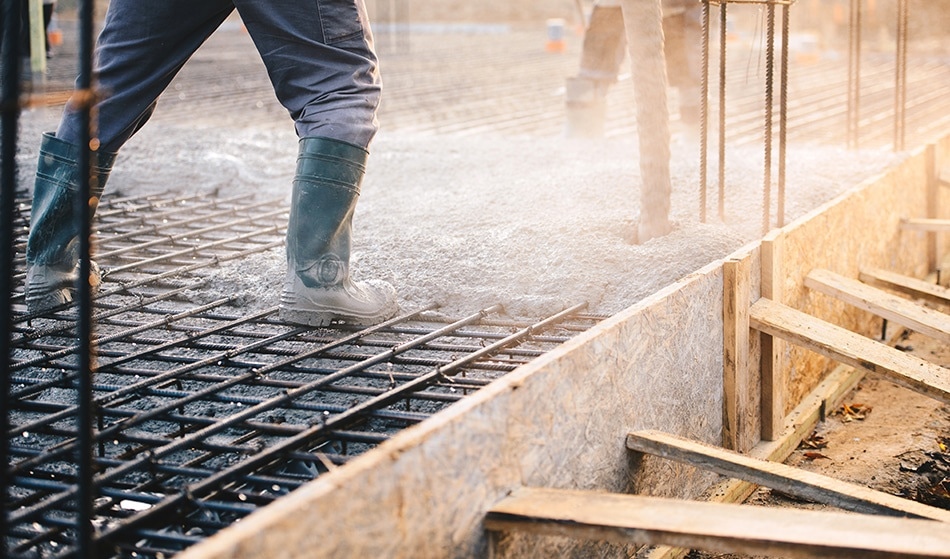
Image Credits: bubutu/shutterstock.com
Builders have been using reinforced concrete since prehistoric times, and over the millennia, this technology has evolved. In its most primitive forms, reinforced concrete contained straw and horsehair, while today, we use everything from steel bars synthetic fibers.
Developed in the 19th century, steel bar-reinforced concrete is still widely used today. While fiber-reinforced concrete does offer superior long-term performance, it can be cost-prohibitive. Both types of reinforced concrete do offer major benefits over standard concrete.
Steel Bar-Reinforced Concrete
Steel and concrete naturally complement one another, and steel bar-reinforced concrete offers superior resistance to compressive, shear and other forces that typically acts on concrete structures. Standard non-reinforced concrete can tolerate compressive stress but doesn't withstand strong stresses like those brought on by earthquakes and powerful winds.
This classic kind of reinforced concrete is still used in a wide range of applications today due to the many benefits it offers, including:
Higher Stress Resistance
Non-reinforced concrete is an ideal construction material for toughness and durability, however, it has been known to fail in high-stress situations, like during major earthquakes and storms. Hence, the reinforcing of concrete with steel has become the go-to construction approach for disaster-prone regions.
Wide Range of Shapes
Reinforced concrete is often made by pouring concrete over a steel frame that has been fabricated into a desired shape. This makes steel-reinforced concrete extremely useful designs and shapes, like domes and archways, capable of withstanding strong forces acting upon them.
Ease of Use
The use of reinforced concrete often requires less labor than non-reinforce concrete. The steel framework is typically pre-fabricated by a manufacturer, and the concrete mix is placed over the framework by pouring or spraying, both of which take relatively little time or labor. As soon as the concrete is applied, it is left to dry.
Because steel reinforce concrete makes for faster construction, it reduces per-hour labor costs. It may require as much as 50 percent less labor to create a steel-reinforced concrete structure.
Fiber-Reinforce Concrete
Although steel bar-reinforced concrete is extremely useful, the steel inside it can corrode over the course of decades, to the point that it reaches structural failure. Concrete reinforced with fibers offers a more dependable long-term alternative. Types of fiber-reinforce concrete include glass fiber-reinforced concrete (GFRC) and steel fiber-reinforced concrete (SFRC).
Used for the last 25 years, GFRC is a relatively flexible and extremely strong material that is highly resistant to damage from the environment. This lightweight building material can be used to create simple or intricate shapes.
SFRC is a composite material that is made of hydraulic cements with steel fibers arbitrarily dispersed throughout. The steel fibers reinforce concrete by giving it the capacity to tolerate tensile cracking. The flexural strength of SFRC is significantly more than that of un-reinforced concrete. Reinforcement of concrete by steel fibers enhances the ability to resist cracking, disintegration, and fatigue. Corrosion is not as big an issue with SFRC as it is with steel-reinforced concrete
More Versatility
Able to be sprayed or poured, fiber-reinforced concrete can conform to almost any shape, including molds with intricate, ornamental details. Also, since it is strengthened internally, there is no need for other types of reinforcement, which can be challenging to form into intricate shapes.
Easy Consolidation
If fiber-reinforced concrete is sprayed, vibration is not needed to consolidate it. If it is poured, vibration or rollers can be used achieve consolidation.
Lighter
Fiber-reinforced concrete can be useful in very thin layers and is therefore a structure made with it can be as much as 75 percent lighter than an identical structure made with traditional concrete. Because fiber-reinforced concrete weighs a small fraction of conventional concrete, it allows for the creation of lighter foundations and the reduction of shipping costs.
Sources and Further Reading
Disclaimer: The views expressed here are those of the author expressed in their private capacity and do not necessarily represent the views of AZoM.com Limited T/A AZoNetwork the owner and operator of this website. This disclaimer forms part of the Terms and conditions of use of this website.